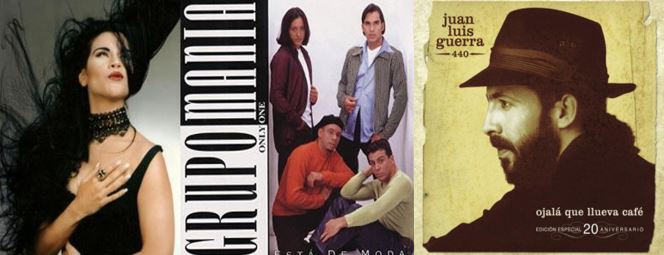Merengue took a page from Salsa’s evolution book, changing to romantic themes and modernizing its sound. This was in stark contrast to the themes and sound of the bands of the 70s.
With these changes, merengue found rapid acceptance of its catchy dance rhythm among young Latin music fans.
The Re-birth of Merengue
Through the 1980s Merengue experienced a downturn after its huge popularity in the late 1970s. That popularity had been led by Johnny Ventura, Wilfrido Vargas, el Conjunto Quisqueya and Josie Esteban. However, in the early 1990s, Merengue decided to borrow a page from the Salsa book to revitalize its genre.
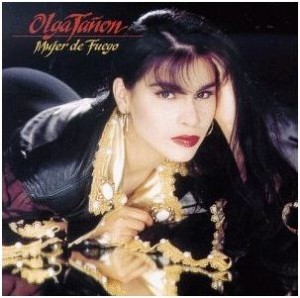
Merengue artists began using romantic themes instead of macho and double-meaning ones. Converting popular ballads to merengue was part of doing that. New, young, good-looking faces (and bodies) with new romantic-type of songs began appearing on the scene and snowballing in popularity.
Artists like Olga Tañon, Zona Roja, Grupo Manía, Manny Manuel, Giselle, Melina León, and Elvis Crespo came to the light. They began attracting a huge following and releasing mega-hits by the bunches.
Another artist that greatly influenced the rebirth of merengue was Dominican Juan Luis Guerra. With his group 440, Guerra would not only introduce romantic themes but also bring the eventual rebirth of the Bachata genre.
Merengue has always been popular with dancers for its simple dancing steps. Club owners like merengue bands as the audiences dance more and because they normally charge less than Salsa bands. With these factors colluding, the popularity of merengue exploded.
One of the first groups to start the new romantic merengue trend was Chantelle. The all-female Puerto Rican group was formed in 1988 and had three singers, with Olga Tañon being one of them. Chantelle disbanded around 1991 shortly after Olga decided to leave the group to become a soloist.
Olga Tañon, the Mujer de Fuego
Olga Tañon released her debut album “Sola” in 1992. But it would be her next album “Mujer de Fuego” which would propel her to stardom. It contained the hit “Muchacho Malo”, “Contigo o Sin Ti”, and the Omar Alfanno song “No Me Puedes Pedir”. The fire kept burning with her 1994 album “Siente el Amor”. It contained the hits “Una Noche Mas”, “Es Mentiroso”, and “Desesperadamente Tuya”. With this second mega-hit album, Olga was cemented as a merengue star.
The Bombazo of Grupo Mania
While Olga Tañon was launching her solo career, Grupo Mania came into the merengue scene. The Puerto Rican band followed the path laid out by merengue band Zona Roja. They introduced a sound anchored in a strong and funky bass.
Their first two albums “A Bombazo…Sí” (1993) and “Explotó el Bombazo” (1994) catapulted the band into immediate stardom. The first album had the hits “Enamorado” and “Dos Mujeres”. But, like most other artists, it was the 2nd album that put them on the map. For this album, Elvis Crespo, who would later become a solo star, joined the band. “Expolotó el Bombazo” included the hits “Cuantas Mujeres” and “La Mania”. It also included “Por Culpa de Tus Celos” written by Raldy Vazquez. Raldy had also written several songs for the Olga Tañon albums of this period.
Other Romantic Merengue Stars
As the ’90s progressed, more artists kept coming into the new romantic merengue scene. Most of them were young, talented, and good-looking.
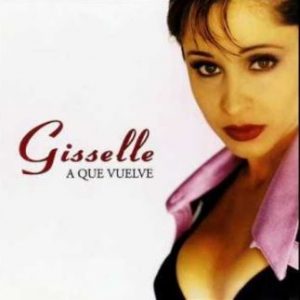
Manny Manuel debuted album “Especialmente Para Ti” was released in 1994. But like others, his 2nd album, “Rey de Corazones” got him name recognition. It included the hits “Distanciado (La Foto)” written (again) by Raldy Vazquez, and the Juan Gabriel ballad “Pero Que Necesidad” in merengue format.
Other notable artists enjoyed successful careers in merengue for several years to come. These include Giselle, who debuted in 1995 with a self-titled album. But again, it was her 2nd album “A Que Vuelve” that send her to stardom. The album sold 200,000 copies. Here 3rd album “Quiero Estar Contigo” also did very well. Giselle would later diversify into ballads and is now a local radio host in Puerto Rico.
Melina Leon debuted in 1997 with the successful album “Mujeres Liberadas”. The album reached #9 on the Billboard Tropical Album list. Her next 3 albums did progressively better. “Con Los Pies Sobre La Tierra” (1998) reached #5, “Baño de Luna” (2000) reached #3, and “Corazon de Mujer” (2001) finally reached #1 on the same Billboard list.
The Controversial Elvis Crespo
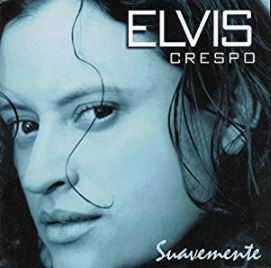
It would be in 1998 that Elvis Crespo decided to leave Grupo Mania to launch on his own. His debut album “Suavemente” was an immediate hit with the title song.
Elvis continued using the heavy bass funky sound that had gained him fame with Grupo Mania. “Suavemente” was the first merengue album to peak at #1 in the Billboard Top Latin Albums chart. The album also contained the mega-hit “Tu Sonrisa”.
His follow-up album “Pintame” (1999) also climbed to #1 on the Billboard Latin Albums and Tropical Albums lists. Besides that, it won a Grammy for Best Merengue Album.
Elvis would continue a successful career for a few years, mostly riding on the success of these two albums. He would later begin to get into personal problems due to sexual accusations against him.
Juan Luis Guerra and 440; Re-Defined Merengue & Bachata
One of the main elements in the revival of merengue was Dominican singer-bandleader Juan Luis Guerra. Juan Luis’s early college education was in philosophy and literature. After that, he studied guitar and music theory before going to Berklee College of Music for a degree in Jazz composition. All this prepared Juan Luis Guerra for what was to come.
Upon forming his group 440 around 1984, Juan Luis began writing songs of both romantic and social themes. His first two albums “Mudanza y Acarreo” (1985) and “Mientras Mas lo Pienso…Tu” (1987) were good albums. But in his case, it would be the 3rd album “Ojala Que Llueva Café” (1988) which earned him international recognition and success.
The title song of “Ojala Que Llueva Café” became a mega hit. It established for the world a new style of merengue. This was more refined music, with a social lyric that resembled Willie Colon and Ruben Blades in “Siembra”. The 2nd single of the album, “Visa Para un Sueno” was also a social theme.
However, the album also had romantic songs like “Razones” and “De Tu Boca”. This set the stage for his follow-up album “Bachata Rosa”.
“Bachata Rosa” Changes Bachata
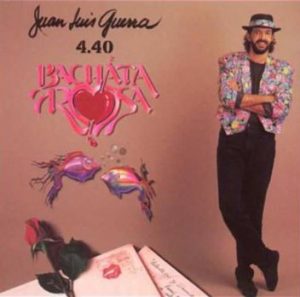
Following “Ojala Que Llueva Café”, the album “Bachata Rosa” (1990) became an even bigger hit. It remained the top-selling album on the Billboard Tropical Album chart for 24 weeks. The mixture of rhythms between merengue, salsa, and bachata. Keep in mind that until then, bachata was considered music from the rural areas of the Dominican Republic, with lyrics too crude and vulgar for the general public. Juan Luis began experimenting with the genre, modifying the lyrics to a more subtle (or rose rather than red) tone.
The album included four bachatas. The first single “Como Abeja al Panal” is a romantic song that starts as bachata and converts into Salsa. The orchestration along with the romantic merengues and bachata proved an irresistible combination. The album consolidated Juan Luis Guerra as an international star. In doing so, it would eventually bring the rebirth of Bachata as a romantic genre.
Juan Luis Guerra and 440 would release 3 more albums in the 1990s. “Areíto” (1992), “Fogoraté” (1994), and “Ni es lo Mismo, Ni es Igual” (1998), where none obtained the success of their previous two predecessors, but still added hits to the Guerra and 440 repertoire.
Merengue’s Threat to Salsa Music
The tremendous growth of merengue’s popularity was undeniable. Using romantic themes with what already was a very catchy and danceable rhythm, it conquered the radio waves and the nightclubs. Merengue went mainstream and was everywhere.
This threat was highlighted in the movie “El Cantante”, based on the life of Salsa star Hector Lavoe. In the movie, the character of Willie Colon is talking to Hector Lavoe about his need to return to the Salsa scene. Hector had one of these downfalls and had taken an extended time off.
Willie mentions to Hector the merengue threat saying. “..the merengue…will finish with you, with me, with Fania, with all. They are going to bury all of us. We need to get out there so that people know we are here”.
The real Willie Colon said in an interview that only 15% of what was shown in the movie was accurate. I’m not sure if his quote above was part of the 15%, but it certainly reflects the thinking at the time. However, this conversation, if real, must have taken place in the late ’80s. Hector died in 1993 when the wave of romantic merengue was just getting started. So if things were bad for Salsa in the late ’80s, it would be worst through the 90s.
Next: Salsa Music Today
With the rise of merengue, and the diminishing number of venues, most Salsa artists began to struggle to find work. Salsa artists in Puerto Rico and New York recurred to frequent tours to other cities in the continental United States, Europe, and Latin America to keep food on the table.
But Salsa was not done. The nostalgic call for more Salsa Dura and a twist from the romantic formula to a more “pop” formula would give Salsa a chance to survive.

